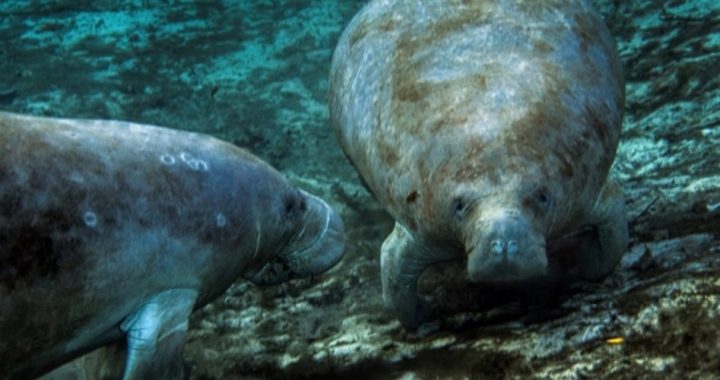
Florida’s manatees are among the world’s animals most vulnerable to human activity. The three living species of manatees (also known as sea cows) are, along with the dugong of the Indian Ocean, the only surviving members of an ancient order of mammals known as sirenids, which are thought to be distant aquatic kin of the elephant. They are also thought to have been the inspiration for mermaid legends, although manatees bear little resemblance to the fabled water maidens. Manatees are slow-moving, docile, and trusting, making them easy prey for anyone wanting to use them for target practice and vulnerable to boat propellers and other hazards (a fifth modern species of sirenid, the gigantic Steller’s sea cow of the Bering Sea, was wiped out by hungry Russian sailors within two decades of its discovery in the late 1700s). They browse on aquatic vegetation in the warm waters of the Amazon, the Caribbean, and Florida’s inland waterways.
Back in the 1960s, the manatee was close to extinction in Florida, owing to habitat loss and frequent collisions with boats. Manatees are also — because of their very low metabolism — exceptionally vulnerable to cold temperatures, and typically sicken and die if water temperatures fall much below 68 degrees Fahrenheit. And it is this sensitivity that has brought the charismatic manatee into direct conflict with the agenda of the climate-change fanatics.
In the wake of last fall’s climate conference in Paris, the Obama administration is rushing ahead with a welter of new regulations and controls before the end of the president’s term in office. Among these new initiatives, first drafted in 2014, is the Clean Power Plan, whose stated objective is “to reduce carbon dioxide emissions by 32 percent from 2005 levels by 2030.” According to the Obama administration’s official description, the Clean Power Plan will, by 2030, produce “tens of thousands of new jobs,” “prevent 90,000 asthma attacks in children,” “prevent 1700 non-fatal heart attacks,” and in general bless Americans with greater health and prosperity.
The trouble is, the Clean Power Plan will also force the closure of many coal-fired power plants, including two major ones in Florida, the Big Bend Power Station and the Crystal River Plant. But power plants such as these are critical to the continued health of Florida’s manatee population, because the creatures flourish in the warm water emitted by the plants. So pivotal are these plants to the well-being of the species that the Fish and Wildlife Service estimates that two-thirds of the entire Florida manatee population is dependent on the warm water produced by them.
Many of Florida’s power plants have Manatee Protection Plans as part of federal Clean Water Act requirements — this, because the manatee, while no longer on the endangered species list, is still considered “threatened” and thereby protected under the Endangered Species Act.
The Endangered Species Act requires federal agencies to consult with the Fish and Wildlife Service or the National Marine Fisheries Service (both of whose jurisdictions cover manatees) any time a proposed regulation impacts a federally protected species. In 2014, when the first draft of the proposed new climate regulations was prepared, the potential effect on manatees was ignored.
The threat to manatees has not gone unnoticed in Congress, some of whose members have demanded information from the EPA. The EPA, for its part, blithely tried to evade responsibility, claiming at first that no consultation was required because the power plant regulations were a state-level matter.
The Obama administration, however, does not intend for such a niggling matter as the welfare of manatees to interfere with the grand cause of saving the climate. As a Wall Street Journal piece noted wryly: “The Administration knows this is legally risky business…. But the White House and EPA are willing to risk a legal rebuke on manatees on the bet that its climate regime will be too entrenched by the time a court considers it. Mr. Obama is in a rush to get his new climate machinery in place so a future President will find it hard to dismantle.”
Tussles such as this reveal not only the ideological inconsistency but also the overarching agenda of radical environmentalism. Environmental extremists adhere to the laws they themselves have created — such as the Endangered Species Act — only when it is politically expedient for them, but expect nothing less than complete and unconditional obedience from the rest of us.
Species such as polar bears, whose alleged plight squares with the political aims of the global-warming alarmists, are routinely invoked to elicit sympathy for the plight of fragile Mother Earth. Others, such as the gentle manatee (which, be it noted, has never been known to hunt and eat humans or rip hapless baby seals to bloody ribbons and, unlike the polar bear, actually lives in areas frequented by large numbers of people, and is a major tourist attraction), are cynically disregarded for their inconvenient need of warmth.
In point of fact, far more species probably prefer warmer temperatures, like the manatee, since the overwhelming majority of all species of living things, both in water and on dry land, live in the tropics, not in the polar regions.
But none of this matters to the fanatics bent on reversing centuries of industrial progress in the name of preventing anthropogenic global warming. That’s because their real agenda is amassing power, not saving endangered species. Climate change is proving to be the most effective pretext for Big Government ever devised; it has given rise to an unprecedented global regime of environmental standards and controls, and empowered countless tens of thousands of power-hungry bureaucrats worldwide. The proponents of Chicken Little environmentalism have nothing less than an environment-inspired global socialist regime as their ultimate goal. They are unlikely to let the well-being of the manatee stand in their way.


